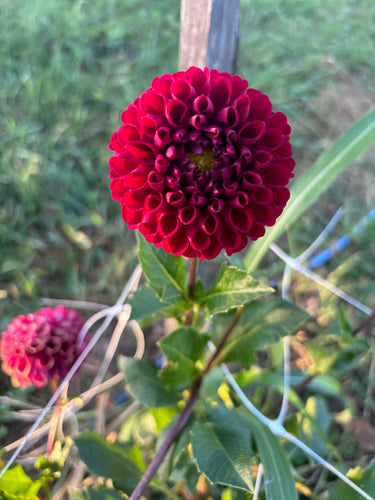
How to Plant Dahlias in Your Garden: Cuttings, Tubers, and Seeds
Share
How to Plant Dahlias in Your Garden: Cuttings, Tubers, and Seeds
Dahlias are a favorite among gardeners for their stunning blooms, wide variety of colors, and ability to thrive in most gardens. Whether you’re a seasoned green thumb or just starting out, there are three main ways to plant dahlias: cuttings, tubers, and seeds. Each method has its benefits, and understanding the differences will help you decide which is best for your garden goals.
1. Planting Dahlias from Tubers
What Are Tubers?
Tubers are the most common way to grow dahlias. They are underground storage structures that resemble potatoes, and each one contains all the nutrients and energy needed to grow a new plant.
Steps to Plant Tubers:
- Choose the Right Spot: Select a sunny location with well-draining soil. Dahlias thrive in 6–8 hours of sunlight daily.
- Prepare the Soil: Enrich your soil with compost or organic matter for better drainage and nutrients.
-
Plant the Tuber:
- Dig a hole about 4–6 inches deep.
- Lay the tuber horizontally with the eye (growth point) facing up.
- Cover with 2–3 inches of soil initially; add more soil as the plant grows.
- Spacing: Space tubers 12–18 inches apart for smaller varieties and 18–24 inches apart for larger ones.
- Watering: Wait to water until sprouts appear, then water deeply once or twice a week.
Benefits of Tubers:
- Easy to plant.
- Produces large, mature plants with consistent blooms.
- Great for replicating favorite varieties.
2. Planting Dahlias from Cuttings
What Are Cuttings?
Cuttings are small pieces of new growth taken from a parent plant or tuber. These cuttings are rooted to create entirely new plants.
Steps to Plant Cuttings:
- Take the Cutting: If starting from a tuber indoors, allow the tuber to sprout and grow 3–4-inch shoots. Cut just below a leaf node.
- Root the Cutting: Place the cutting in a moist potting mix or water until roots develop. This takes about 2–3 weeks.
-
Transplant to the Garden:
- Once roots are strong and the risk of frost has passed, transplant the cutting into your garden.
- Plant the cutting at the same depth as it was in the pot.
- Care: Keep the soil evenly moist and protect young plants from extreme weather.
Benefits of Cuttings:
- Quick and affordable way to multiply plants.
- Produces clones of the parent plant, ensuring uniform blooms.
- Smaller storage needs compared to tubers.
3. Planting Dahlias from Seeds
What Are Seeds?
Dahlia seeds are harvested from the flowers and can grow into entirely new plants. Unlike tubers or cuttings, plants grown from seeds may not look like their parent due to genetic variation.
Steps to Plant Seeds:
- Start Indoors: Start seeds indoors 6–8 weeks before the last frost. Use seed trays filled with a light, well-draining potting mix.
- Sow the Seeds: Plant seeds about ¼ inch deep, cover lightly with soil, and keep moist.
- Provide Warmth and Light: Place trays in a warm, bright location (or use grow lights).
-
Transplant Outdoors: Once seedlings are 3–4 inches tall and the risk of frost has passed, transplant them to the garden.
- Space plants 12–18 inches apart.
- Water regularly to keep soil evenly moist.
Benefits of Seeds:
- Affordable way to grow many plants.
- Perfect for experimenting with new and unique flower varieties.
- Great for creating your own hybrids.
Which Method Is Right for You?
| Method | Best For | Pros | Cons |
|---|---|---|---|
| Tubers | Gardeners seeking reliable blooms | Consistent results, mature plants | Requires more storage space over winter |
| Cuttings | Multiplying favorite varieties | Affordable, clones of parent plant | Needs indoor setup for rooting |
| Seeds | Experimenting with new varieties | Affordable, potential for unique blooms | Takes longer to mature, unpredictable |
Tips for Success, No Matter the Method
- Choose the Right Spot: Dahlias love full sun and well-draining soil.
- Fertilize Regularly: Use a low-nitrogen fertilizer to encourage blooms instead of leafy growth.
- Stake Tall Varieties: Many dahlias grow tall and benefit from staking to prevent bending or breaking.
- Water Wisely: Keep soil moist but not soggy. Overwatering can lead to rot.
Conclusion
Whether you’re planting tubers, cuttings, or seeds, dahlias are a rewarding addition to any garden. Each method offers unique benefits, so you can choose based on your gardening goals, experience level, and available resources. With proper care, these beautiful blooms will provide a stunning display all season long.
Ready to start your dahlia-growing journey? Pick your method and watch your garden come to life with color and beauty! 🌸
